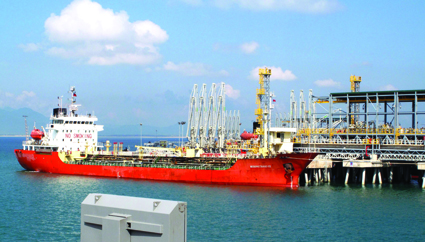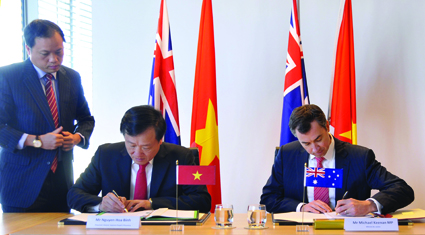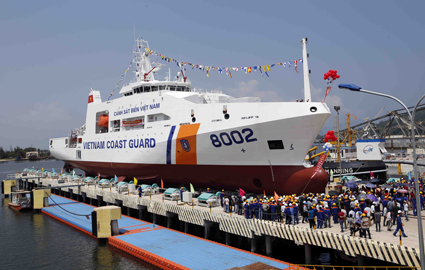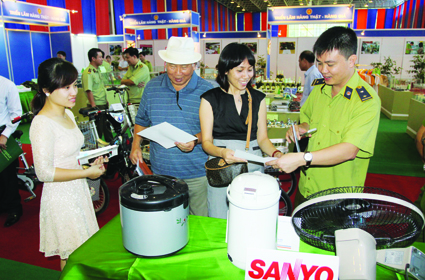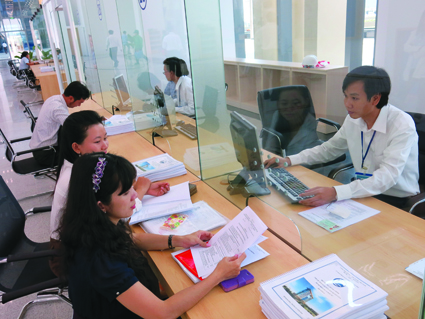Dang Xuan Phuong, Ph.D of law
Vice President
Institute for Legislative Studies of
the National Assembly Standing Committee
The agenda of the Second Standing Committee on Sustainable Development, Finance and Trade of the Inter-Parliamentary Union (IPU) has identified an important theme attached to the Millennium Development Goals (MDGs) for discussion at the 132nd IPU Assembly to be held in Hanoi in late March, 2015, namely “Shaping a new system on water governance: Promoting parliamentary action on water.” In order to contribute to recommendations of the Vietnamese National Assembly delegation on the IPU-132’s resolution on that theme, this article presents the situation of building a new institution on water governance in Vietnam over the recent time and its challenges; a model institution of water governance taking into account Vietnam’s particular conditions; and necessary steps to be taken by the National Assembly to shape and operate a more effective water governance mechanism in Vietnam.
 |
Pongour waterfall in Lam Dong province__Photo: Internet
|
Situation of and challenges to the completion of the system of institutions on water governance in Vietnam in the process of international integration
As a Southeast Asian nation with an age-old agricultural tradition, water and water control in Vietnam is always an issue of prime importance in its economic and water-induced disaster prevention and control policies through different historical periods. Today, water governance is related to the management functions and duties of different economic sectors and fields: agricultural irrigation, aquaculture, industrial manufacture and processing, urban and rural water supply and drainage, waterway navigation, power generation, tourism, etc. As a country with abundant water sources thanks to its typical geographical and climatic conditions (on average, every Vietnamese has around 9.85 m3 of surface water, 1.5 times higher the average per capita water volume in the world according to a 2008 report) and suffering a protracted wartime, Vietnam’s water governance is still based on traditional methods and mainly serves agriculture and rural areas where live 70-80 percent of its population. In the past two decades, the water governance institution in Vietnam has progressed toward higher effectiveness and sustainability of the exploitation, use and protection of water as a precious natural resource, especially in the context that this natural resource is facing great challenges of multi-purpose use, much greater demand for clean water due to population growth, speedy urbanization and quickly increasing environmental pollution and degradation. These challenges are largely attributable to wastewater and depletion of aquatic ecosystems in the river basins and coastal areas. Another water-related extremely significant challenge related to the strategic national security issue is that most of natural sources of water in Vietnam’s large rivers come from neighboring countries which themselves have growing demands for water for their development objectives.
Vietnam has undergone a deep and wide institutional reform in the field of water governance since late 1990s. From 1998 when the first-ever Law on Water Resources was enacted (when the Ministry of Agriculture and Rural Development (MARD) was assigned with the function of state management of water resources) to 2012 when this Law (drafted by the Ministry of Natural Resources and Environment (MONRE) according to its functions assigned in 2002) was revised by the National Assembly, the institutional framework for the state management of water resources in general and water governance in particular have seen remarkable progresses in the management thinking and legal grounds in the direction that in the general mechanism for water governance the function of state management of water resources (based on the general and objective principles) must be separated from the function of management of water exploitation and use in different economic sectors and fields. This is the common trend of water governance reform in the countries around the world, especially in the Southeast Asia, over the recent time. With consultations and recommendations of the MONRE, legal instruments for the state management of water resources have been constantly improved. They include the National Strategy for Water Resources (issued in 2006), various master plans on water resources, Government Decree No. 120/2008/ND-CP on management of river basins, Decree No. 112/2008/ND-CP on integrated management, protection and exploitation of natural resources and environment in reservoirs and hydropower reservoirs, various decrees on sanctioning of administrative violations in the field of water resources; Prime Minister decisions promulgating the inter-reservoir operation processes in river basins, etc. The established legal framework on water resources has promoted the renewal of the mechanisms for management, operation and use of works and services in many water-using sectors, such as irrigation, aquaculture, hydropower generation, inland waterway transportation and environmental protection, toward multi-purpose use of water. It can be said that the building of institutions and policies on state management of water resources has importantly contributed to raising awareness about the necessity of and step by step pushing forward the reform of the water governance mechanism toward the integrated management approach (or in essence the integrated management of water issues involving responsibilities of many ministries, sectors, fields, local administrations and social communities).
However, the current mechanism for formulating policies and strategies on water governance reveals a shortcoming that the National Council on Water Resources, founded in 2000 (with a Deputy Prime Minister as its Chairman and the MONRE as its standing body) is working ineffectively because the Council, composed largely of representatives from administrative agencies and working on a part-time basis, has very little time every year to discuss water-related issues of global and national importance which require very specialized knowledge. The responsibility to advise the Government and Prime Minister rests mainly upon the ministry in charge of state management of water resources which, when having to tackle important tasks related to water exploitation and use under the management by other ministries and sectors in the capacity as “an arbitrator,” has often come up with a compromising plan rather than a long-term optimal solution. The elaboration of a master plan on water resources aiming to ensure integration and connection with sectoral master plans related to water exploitation and use is still underway while the institutional framework for the formulation of master plans and strategies remains incomplete until the promulgation of a law on spatial planning.
Regarding the state management apparatus, after taking over the function of state management of water resources from the MARD in 2002, the MONRE has so far built a relatively complete state management apparatus (the Water Resources Management Department at the central level and water resources management sub-departments under provincial-level Natural Resources and Environment Departments) and non-business units, initially meeting the requirements of management and provision of public services. The division of the state management functions, powers and responsibility between the MONRE and the MARD has been completed. The MARD has established the General Department of Irrigation to manage agricultural irrigation works, dikes and flood and storm prevention and control, focusing on the state management of water-related public services, except urban water supply and drainage under the management of the Ministry of Construction.
Regarding the territory-based organization of power for water governance, Vietnam’s traditional practice of assignment of management power among various sectors and fields and decentralization of management power to different administration levels corresponding to administrative units has encountered a big challenge when it comes to dealing with issues of water sources in inter-provincial regions. Since water resources are naturally located according to river basins which often stretch over many localities (Vietnam now has 108 river basins, including 16 major river basins), they need to be managed based on river basins. Meanwhile, the river basin-based water management mechanism remains incomplete and is just applied to dealing with a long-term inter-sectoral issue rather than settling simultaneously many multi-sectoral and inter-regional issues according to the river basin management requirements. For instance, the MARD previously established river basin planning management boards exclusively for the irrigation sector and the MONRE has proposed the establishment of river basin environmental protection committees (to date, there are only environmental protection committees for Cau river, Nhue-Day rivers and Dong Nai river system). Yet, these model inter-sectoral coordination mechanisms are not river basin organizations currently operating in countries with advanced water governance levels. Finding an organizational model and a river basin-based integrated management mechanism suitable to Vietnam’s conditions has become a key issue in the implementation of the 2012 Law on Water Resources.
Regarding investment and finance policies for the water sector, over the past decades, Vietnam, being an agricultural country at the starting point, has invested large budget funds in the state-subsidized water sector’s water exploitation and use facilities, which are hardly recovered for reinvestment. The wasteful use of water is rather widespread due to lack of a rational water source distribution mechanism. Charges for water supply and drainage and wastewater treatment services have been collected from urban dwellers but remain unproportional compared to the requirement of considering water as a commodity under the principles set out by the 1992 Dublin Statement on Water and Sustainable Development. The irrigation fee exemption applied since 2008 has not only caused a loss of billions dong to the state budget but also, as assessed, led to inequality in the access to water services (many aquatic product producers and service enterprises are enjoying great incentives in water use without having to pay fees corresponding to their revenues). Meanwhile, communities and people that have rights and responsibilities in the exploitation, use and protection of water sources still have no effective mechanism to ensure adequate and fair participation of all stakeholders in the water governance and distribution of benefits from water.
Institutional model for water management in Vietnam - orientations and solutions for renewal and completion
It is obvious that the institution and organizational structure of water resources management in general and water governance in particular in our country have been step by step renewed in line with the common global trend toward reforming the water sector and sustainable development. However, the current institutional framework still has shortcomings in addressing rather basic issues related to the method of integrated water resources management in the stages of planning, organization-administration and implementation. At present, the absence of an effective legal framework for a regional-level sustainable development management institution is a big question. Whether this institution should only concentrate on socio-economic management or must be integrated with and based on natural conditions related to environment and natural resources, including the most two important resources being water and land? Deeper researches into theoretical and practical grounds on building a sustainable development model can put forth satisfactory answers to these institutional questions in the future (e.g., in France the Ministry of Ecology, Sustainable Development and Energy has been established to perform integrated management of environment, natural resources, transport, energy and sea). However, in the immediate time, efforts should be concentrated on the following work related to the building of a water governance institutional model:
Firstly, it is necessary to renew the composition and working method of the National Council on Water Resources in order to improve the quality of the consulting, planning and coordination of the implementation of national strategies and policies on water resources. The Council should have a broader membership with specialists and representatives of the main “interest” groups of water users. The Council should work on a more regular basis and can be convened at any time when necessary to review policy proposals, national projects or foreign-involved projects related to water. This working regime of the Council can replace many inter-sectoral meetings chaired by the Government Office or the MONRE.
Secondly, in order to enable the river basin organization to fulfill the function of water resources planning and coordination on a regional scale (embracing river basins), it is necessary to rely on international experiences and take into account Vietnam’s particular conditions to design a flexible model for this organization. Generally, there should be a two-tier structure as follows:
(i) The planning-policy management tier: To establish both the River Basin Council for the major national river basins (such as the Mekong River basin and the Red River - Thai Binh River basin) and the River Basin Committee (for smaller river basins covering several province and cities). Due to the terrain characteristic of Vietnam which is long and larger at the two ends, the establishment of either the council model or committee model is inappropriate. For the two major river basins of the country where water governance is more complicated and has long-term effects on the national development, there should be a mechanism that can mobilize and rally more specialists, managers and local representatives compared to other river basins (mainly situated along the country’s central coast). Such Council should have the chairperson being the Minister of Natural Resources and Environment and two vice chairpersons including a Deputy Minister of this ministry and a Deputy Minister of Planning and Investment. Meanwhile, the committees established for smaller river basins can operate with a local leader as its chairperson (for a river basin located within or largely within a province or city) or an alternating chairperson for a river basin covering several provinces), and members being representatives from the MONRE and other ministries and sectors with the water governance function, local representatives, and specialists.
(ii) The implementation-organizing tier: To establish the River Basin Management Board (in charge of both water resources and environment) attached to the MONRE (for the two major river basins), to the Water Resources Management Department (for river basins covering several provinces), or to provincial-level Natural Resources and Environment Departments (for river basins lying within or largely within a province). The River Basin Management Board should be a non-business unit operating on the self-financing principle and functioning to conduct baseline surveys, elaborating, and supervising the implementation of, master plans on exploitation, use and protection of water resources in the river basin. Step by step, it is possible to adjust and add the functions and tasks of the Board to serve state management work. The national river basin system management boards may be established on the basis of strengthening the meteo-geological investigation federations of the northern and southern regions (which are now attached to the National Center for Water Resources Planning and Investigation).
The regional river basin-based water resources management structures should be reorganized uniformly and allowed to make decisions on supervision, licensing and implementation issues, ensuring proper and timely settlement of water governance issues in the regions. This restructuring will also permit the improvement of the apparatus of the Water Resources Management Department to concentrate more on the advising, inspecting and supervising functions.
Thirdly, it is necessary to restructure the relationship in territory-based state power to minimize irrationalities and overlaps in functions, tasks and powers between central government agencies and provincial-level administrations upon establishment of river basin organizations under the 2012 Law on Water Resources. This relationship should be taken into consideration right in the process of formulating and implementing the Law on Organization of Local Administrations, which is expected to be passed at the coming National Assembly session in May 2015, and its implementing regulations. The Government should promulgate as soon as possible decrees on the integrated management mechanism for the two major national river basins and a common management mechanism for other river basins. In this regard, natural resources and environment management responsibilities should be decentralized to provinces and cities based on the particular geo-economic characteristics of each region. More reasonable decentralization is needed for localities in regions that require connectivity with neighboring provinces and cities with higher natural and economic conditions through the region- or river basin-based integrated management model. In this light, the decentralization of the finance management and distribution of tax and fee revenues related to the water resources exploitation, use and protection should be also re-calculated to be more appropriate to each locality (some localities will have greater autonomy and higher revenue rates than others). The river basin-based integrated water resources and environment management mechanism should also be closely associated with the integrated management of coastal areas in the major river basins.
Fourthly, management of river basin water resources is implemented according to river basin master plans and integrated management programs and plans by the river basin organizations as decentralized, with the support of the water resources management agency under the MONRE and related local administrations. However, in order to promote the effectiveness of the water resource integrated management mechanism in conformity with the second principle of the 1992 Dublin Declaration, there should be a mechanism to increase the involvement of the production and consumption circles, communities of indigenous inhabitants and specialists throughout the process of planning, implementation and supervision of the river basin water resources integrated management master plans, programs and plans (through the mass media, opinion polls and the performance of the accountability of state authorities). The 2013 Constitution has affirmed the principle that the people have the right to exercise their power through direct democracy as well as representative democracy. It is necessary to study and complete theoretical and practical grounds for issuing regulations and rules to guarantee the implementation of this constitutional principle concerning this issue.
Role of and steps to be taken by state power bodies in promoting the shaping and completion of a new mechanism for water governance
Within the framework of activities in response to the IPU-132, including the theme on “Shaping a new water governance mechanism: Promoting parliamentary actions on water,” it is possible to initially identify the role of and basic steps to be taken by the National Assembly and provincial-level People’s Councils in the completion and promotion of the effectiveness of the new water governance mechanism in the coming time as follows:
1. To step up the building of more integrated water governance institutions, specifically concentrating on studying the building of a water governance coordinating organizational model based on the principle of integrated management of natural resources and environmental protection toward sustainable development, remedying limitations of the traditional state management model (by sector and administrative territorial unit); to adjust the mechanism of establishing and distributing revenues from taxes, charges and fees in the water sector to be more reasonable and equitable in response to the requirements on state management responsibility decentralization to different levels and sectors based on particular geo-economic characteristics of each region; to continue to institutionalize the socialization and economicalization of water services on the water user and polluter pay principle, ensuring equitability and minimizing losses and waste in water exploitation and use.
2. To increase the exercise of the power to approve policies and raise the effectiveness of oversight activities of the National Assembly and provincial-level People’s Councils with respect to decisions of state administrative agencies on strategies, master plans and long-term plans and important investment projects related to water exploitation, use and protection.
3. To facilitate the exercise of direct democracy through enhancing the role of social organizations and representatives of communities of indigenous inhabitants and mobilizing specialists to actively participate in water governance activities.
4. To promote the effectiveness and efficiency of administrative and judicial mechanisms permitting better access to water services for the communities of indigenous inhabitants and citizens.
5. To combine parliamentary diplomacy and external-relation communication in order to increase the effectiveness of international cooperation related to water governance and implementation of water treaties.-


